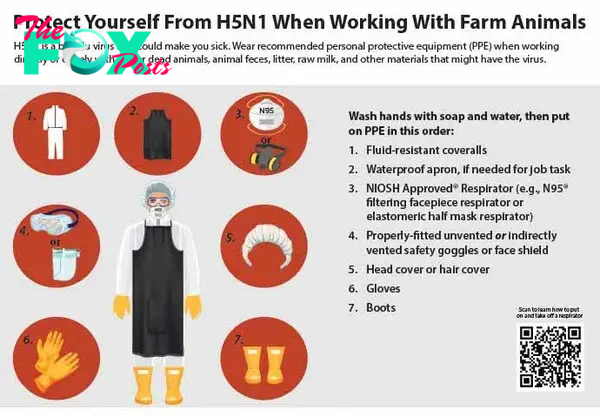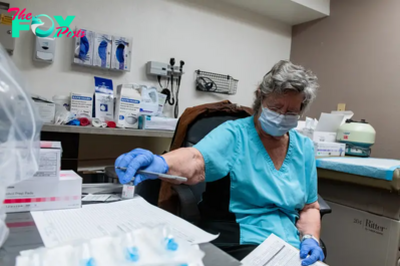Health
How extreme heat in Colorado may have contributed to an extraordinary outbreak of bird flu in people
The outdoor temperature flirted with 100 degrees and heat advisories blanketed the region earlier this month as workers arrived at a commercial poultry operation in Weld County to start killing chickens.
Of the 1.8 million egg-laying hens inside the operation’s barns, at least some were infected with highly pathogenic avian influenza — bird flu. The strain of the virus that is now circling the globe has shown a remarkable ability to infect all kinds of animals, from seals to skunks to mountain lions. But it spreads most rapidly and lethally in wild birds and domestic poultry.
When a commercial flock is infected, standard practice is grim but efficient: Kill all the birds at the farm, devastating one operation in the hopes of stopping the virus and sparing the rest of the industry. By the time the workers in Weld County were done, though, some discovered that the virus had survived at least for one infection longer. It had found a new host: Their own bodies.
The unprecedented cluster of six cases of bird flu reported this month in Colorado is the largest outbreak of human cases in the United States from the current strain — in fact, it is the only time in this country that more than one person has been confirmed to be infected from a single incident. And there is a possibility the outbreak may be worse than the headlines.
Colorado health officials tested at least 69 workers who showed flu-like symptoms, out of more than 150 workers who were at the farm. Of those, only six have tested positive — three of those cases were confirmed initially by the federal Centers for Disease Control and Prevention, while three others were confirmed later, most recently on Friday.
Combined with another human case reported in the state this month — a dairy worker who had contact with infected cattle — as well as the state’s worst-in-the-nation outbreak of bird flu cases on dairy farms, Colorado has become the epicenter of bird flu in the U.S.
A state health official last week said public health agencies are monitoring more than 700 people who may have been exposed to bird flu, looking for signs to see if they were infected. A team from the federal Centers for Disease Control and Prevention arrived in Colorado to help track the epidemiological evidence.
But the outbreak has also shined a light on a much more mundane factor in the infections: Those soaring temperatures.
Why extreme heat contributed to the outbreak
The CDC says that workers who have contact with infected animals should wear a thick suit of personal protective equipment, or PPE.
Head covering, goggles, mask, water-resistant coveralls, apron, gloves and boots. In a drawing of the outfit on the CDC website, only slivers of a worker’s forehead and cheekbones are uncovered.

But there are no requirements for workers to wear PPE. The U.S. Department of Agriculture has issued only recommendations. The state has no requirements, either.
The result is that workers may not be wearing PPE in bird flu hot zones.
“My understanding is that PPE is available to workers, but there’s not been 100% uptake in the use of PPE,” Dr. Rachel Herlihy, the state epidemiologist, said in an interview last week. “We’ve been working very closely with the producer to ensure improvements are made in uptake of PPE in workers. There’s been significant work to train workers on the use of PPE.”
☀️ READ MORE
Individual health insurance rates in Colorado could see below-average increase in 2025
Colorado identifies three new human cases of bird flu and more people are symptomatic
Colorado dropped people from Medicaid at a rate comparable to red states, alarming advocates for the poor
This is where the weather comes in. All that PPE — designed to be fairly un-breathable, in order to keep pathogens out — is hot.
While temperatures outside were scorching, it was likely even hotter inside the barns where the workers were culling birds. Workers may have chosen to forego PPE or taken it off. Sweat running down faces made goggles fog up and masks slip. Large fans pushed around air, likely laden with virus, and ruffled PPE.
Every crack in the protective armor provided an opportunity for the virus to slip through.
“It’s really difficult to try and control the weather right now,” Herlihy said.
Criticisms of the response
While the difficulties of working in extreme heat might explain the outbreak, they don’t offer an excuse for not better protecting workers, some experts said.
“That’s absolutely crazy to me,” said Jennifer Nuzzo, a nationally recognized epidemiologist who is the director of the Pandemic Center at Brown University School of Public Health in Rhode Island. “Putting people into a situation where they are culling birds that are known to be infected without sufficient protection is just gambling with their lives.”
-

 Health8h ago
Health8h agoThe Surprising Benefits of Talking Out Loud to Yourself
-

 Health10h ago
Health10h agoDoctor’s bills often come with sticker shock for patients − but health insurance could be reinvented to provide costs upfront
-

 Health1d ago
Health1d agoWhat an HPV Diagnosis Really Means
-

 Health1d ago
Health1d agoThere’s an E. Coli Outbreak in Organic Carrots
-

 Health2d ago
Health2d agoCOVID-19’s Surprising Effect on Cancer
-

 Health3d ago
Health3d agoWhat to Know About How Lupus Affects Weight
-

 Health5d ago
Health5d agoPeople Aren’t Sure About Having Kids. She Helps Them Decide
-

 Health5d ago
Health5d agoFYI: People Don’t Like When You Abbreviate Texts


























